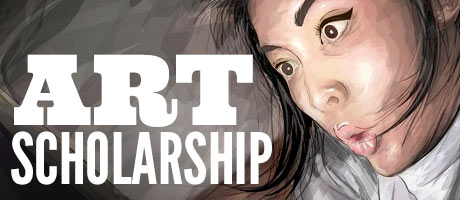Art Scholarships are financial aid awarded to students based on academic or artistic merit or financial need.
Unlike other forms of financial aid, art scholarships do not have to be repaid.
Art scholarships become even more of a necessity as the price of art school tuition increases. With the current financial situation, supplementing your tuition with scholarships is essential to help pay for college.
Differences between art scholarships and regular scholarships
Most scholarships require you to fill out an application listing your scholarly and academic achievements, extra curricular activities, and usually require an essay describing your eligibility for the award.
Art scholarships are very similar in their academic and extra curricular requirements, but also usually include a portfolio requirement and artist’s statement. The portfolio can range from one or two sample images up to ten or more. The portfolio is expected to be tailored to the particular field of study the award is based on. For example, a fine art scholarship committee would require only artwork created using traditional mediums like oil, acrylic, or watercolor, while animation scholarship judges might require a demo reel of digital art samples. The artist’s statement is usually a description of why you want to be an artist, artists you admire, and your artistic goals.
Academics and grade point average (GPA) are still important indicators of your ‘scholarship worthiness’, but they may not be emphasized as highly as a strong portfolio.
Kinds of art scholarships
Scholarships can be divided into several types or categories:
– Portfolio scholarships are awarded based on the strength, quality, and potential of the applicant’s artwork portfolio.
– Academic scholarships are awarded based on SAT/ACT scores, and are evaluated on a scale with consideration for critical reading and math scores.
– Merit scholarships (scholarships combining artistic and academic honors) are awarded based on a combination of artistic skill and academic achievement.
– Need-based scholarships are awarded based solely on the applicant’s financial situation.
– Sociological scholarships are awarded based on the applicants race, religion, or nationality, in addition to academic requirements.
– Institutional scholarships are granted by the school the student attends or plans to attend.
– General scholarships are given by various institutions and organizations associated with by the student or the student’s family, such as industry groups and corporations.
How to find art scholarships
When you are ready to begin your scholarship search, knowing where to look is the key to success.
High School
There are several resources you can tap at your high school. Guidance counselors often keep files or bulletin boards with scholarship opportunities. Art instructors are often involved in the local arts community and may be able to help you find local resources.
College/University
Your art school is the first place you should start your art scholarship search. Many schools have various art scholarship opportunities, for both new and existing students. Contact the admissions department or your major’s department office and ask for information on what scholarships they offer and when the deadlines for application are. Also, visit the school web site and research their Financial Aid section.
Internet / Online
Use your favorite search engine to find art scholarships. Info is freely available at various web sites. Many allow you to sign up for scholarships directly. But beware of any scholarship or service that requires payment to apply. Basic online security applies– never give out sensitive information to an unknown source.
Other potential scholarship sources include:
– Professional organizations
– Art industry and trade groups
– Community and civic groups
– Local businesses
– Art contests
– Your employer (or your parent’s employer) – Many large corporations, like Target or Walmart have scholarship foundations.
– Charitable Foundations
– The Military – There are many scholarships available to the military community.
Tips for Applying for Scholarships
Here are a few tips you should keep in mind when applying for art scholarships:
– Follow the instructions to the letter.
– Be sure to follow the guidelines for essay length, format, number of portfolio images, extra information (or not), etc. It can be tempting to go above and beyond in providing information, but remember that the judges are busy folks and inundating them with irrelevant info will only hurt your chances. According to Josh Barsch of Straightforwardmedia.com, 98% of scholarship applications get tossed in the trash due to mistakes or not following the instructions. See a sample art scholarship application form.
– Give it your best shot.
– Scholarships are intensely competitive, so presenting your absolute best every step of the way (not just on the essay and portfolio) is a must.
– It’s the little things.
– Double and triple check your grammar and spelling on every part of the application. Have several people proofread your essay. Have a third party artist review your portfolio. Make sure your application and other materials are clean and crisp.
– Apply to as many scholarships as you can!
– Never assume any scholarship is a sure win (or a sure loss). You never know whose eye your application might catch. Just be sure you actually meet the qualifications before applying.

